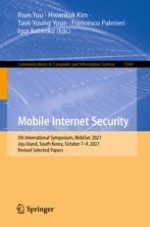2022 | OriginalPaper | Buchkapitel
A Systematic Literature Review on the Mobile Malware Detection Methods
verfasst von : Yu-kyung Kim, Jemin Justin Lee, Myong-Hyun Go, Hae Young Kang, Kyungho Lee
Erschienen in: Mobile Internet Security
Verlag: Springer Nature Singapore
Aktivieren Sie unsere intelligente Suche, um passende Fachinhalte oder Patente zu finden.
Wählen Sie Textabschnitte aus um mit Künstlicher Intelligenz passenden Patente zu finden. powered by
Markieren Sie Textabschnitte, um KI-gestützt weitere passende Inhalte zu finden. powered by
